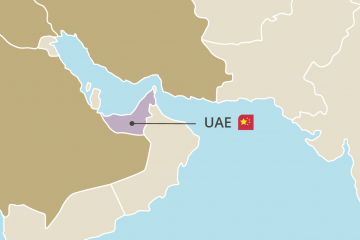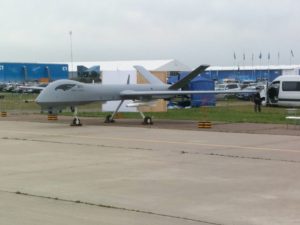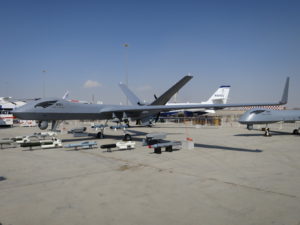
United Arab Emirates
The UAE has invested heavily in the capabilities of its armed forces over the past two decades and has managed to develop one of the most modern and capable militaries in the region, which operates advanced air capabilities even when compared to other wealthy Gulf states.
The UAE’s interest in UAVs emerged in 2013, when it reached a deal to purchase a number of MQ-1 Predator XP and related ground systems from General Atomics, which were delivered in 2017.[1] These were a variant of the MQ-1 Predator specifically modified so that they could not carry weapons. However, soon after the US refused to sell armed drones to the UAE, the country purchased two Wing Loongs, China’s equivalent to the Predator.
In early 2017, the UAE also acquired Wing Loong IIs from CAIG.[2] Although neither China nor the UAE have confirmed the purchase, these UAVs have been spotted at the remote Qusahwirah Air Base.[3]
NOTES
[1] Stanley Carvalho, ‘UAE Signs $1.4 Billion Defense Contracts, Including Drones’, Reuters, 18 February 2013.
[2] Christopher Biggers, ‘UAE Revealed as Wing Loong II Launch Customer’, Jane’s 360, 26 January 2018.
[3] Both the Emirati and Chinese interviewees have been particularly vague and secretive about their relations with the other country, especially when it came to the issue of armed drones. This differed substantially from interviews on the armed drones’ capability and procurement of other countries.
Armed UAV inventory

Drone
Wing Loong
Type
Medium-Altitude Long-Endurance (MALE) UAV
Manufacturer
Chengdu Aircraft Industry Group (CAIG)
Number
5
Endurance
20 hours
Loaded Weight
1,100kg
Payload Capacity
100kg
Range
>1000km with SatCom, ~150km from Ground Control Station (GCS) if not
Sensor Options
capable of being fitted with a variety of sensors, including a forward-looking infrared turret and synthetic aperture radar
Weaponry
Up to 100kg of payload on two wing hardpoints which can include: AKD-10 air-to-surface anti-tank missile; FT-9/50 50-kg bomb; FT-10/25 25-kg bomb; GB-7/50 50-kg PGM

Drone
Wing Loong II
Type
Medium Altitude, Long Endurance (MALE) UAV
Manufacturer
Chengdu Aircraft Industry Group (CAIG)
Number
5
Endurance
Up to 32 hours depending on payload
Loaded Weight
4200kg
Payload Capacity
480kg
Range
>1000km with SatCom, ~150km from Ground Control Station (GCS) if not
Sensor Options
Infra-Red (IR) and Electro-Optical (EO) cameras, and laser designator in sensor ball
Weaponry
Up to 480kg of payload on twelve wing hardpoints which can include: AKD-10 air-to-surface anti-tank missile; BRMI-90 90-mm guided rocket; FT-7/130 130-kg glide bombs; FT-9/50 50-kg bomb; FT-10/25 25-kg bomb; GB-7/50 50-kg PGM; and GB-4/100 PGM
The initial reason for the UAE’s interest in the acquisition of armed UAVs was, similarly to other countries in the region, prestige. However, once acquired, armed drones progressively started being viewed as conferring new military capabilities on the country, enabling it to deal with targets in high-threat operating environments without the same risks and political ramifications.
The UAE has been trying to establish itself as the West’s primary counterterrorism partner in the region since 2016. It has focused particularly on enhancing coordination with the US, which, for instance, used the Al-Dhafra Air Base near Abu Dhabi to fly its own armed UAV sorties over Iraq and Syria targeting Daesh.[1] At the same time, the UAE has also tried to bolster its own military capabilities by engaging in substantial arms’ deals with Beijing, particularly for armed drones.
At least part of the reasoning behind the UAE’s recent purchases of armed UAVs from China appears, besides prestige, to be to convince the US to sell armed versions of its iconic MQ-9 Reaper and MQ-1 Predator UAVs, which are more technically advanced and could be integrated into the UAE air force’s American mission-planning, ISR and C2 systems. This would be in line with the overall Emirate’s desire ‘to maintain the strongest link with the US military sphere’.[2] The recent decision by US President Donald Trump’s administration, following pressure from Congress, to relax some of its restrictions on the export of armed drones might eventually lead to the UAE’s progressive move away from China.[3] However, for the time being, dealing with Beijing allows Abu Dhabi to have quick access to armed UAVs.[4]
Once acquired and introduced into service, armed drones have increasingly been used by the UAE, which has deployed them not only in support of friendly forces on the ground in Yemen, but also to conduct strikes in ‘politically sensitive areas’, such as Libya.[5] On the other hand, for sensitive ISR and target cueing, the unarmed Predator XP is likely to remain the UAV platform of choice since it offers a superior sensor picture and, more crucially, is integrated into the US-supplied C2 and targeting architecture through which the UAE air force runs its operations. The UAE’s Predator XPs may also benefit from US-facilitated satellite control uplinks, allowing them to operate beyond line-of-sight control range of ground stations – unlike the Chinese-supplied Wing Loongs. As with other users in the Middle East with strong military links to the US, concerns about information security preclude American permission for integrating Chinese UAVs into Western command, control, communications and computers architectures, which limits their usefulness beyond self-contained ISR strike missions.
In Yemen, where the Emiratis have been involved in military operations conducted by the Saudi-led coalition against the Houthis since 2015, Wing Loongs have been used mainly in conjunction or in similar ways to the UAE air force’s F-16 fighter jets. Given the coordination with the US, in some cases UAE strikes have been encouraged, since they reduced the pressure and risks taken by US forces.[6] In Libya, on the other hand, while the UAE has denied involvement, it was identified in 2016 as having deployed manned aircraft and Wing Loongs to a base in the east of the country.[7] Wing Loongs appear to also have been provided to Khalifa Haftar’s forces,[8] the Libyan National Army, breaching an international arms embargo.[9]
Unlike other countries in the region, the UAE has been very secretive about its purchase, deployment and use of armed drones. This technology is in fact perceived by high-ranking officials and the military to be a testament to the country’s military capability in the Middle East, as well as a powerful tool to achieve the goal of projecting power in the region, while minimising risks.[10] Troops and equipment losses, in particular, are perceived by the UAE as highly damaging given the limited resources and population of the country. Any new technology which reduces such risks is welcomed by the establishment.[11] In Yemen, for instance, Wing Loong Is and IIs enable the reduction of risks for their pilots and F-16 fighter jets, through the reliance on UAVs to conduct airstrikes.[12]
The UAE is particularly wary of the reputational costs involved in using armed drones and do not want to be viewed as misusing them or causing civilian casualties, ‘want[ing] criticism to go away by doing the right thing’.[13] In practice, this means that while they showcase their interest in meeting benchmarks of international good practice, these are not often translated into their modus operandi. There is no clarity about the C2 procedures in place when using armed drones and, while there is a general sense that a process does exist (precisely to avoid mistakes and consequent criticism), this has not been disclosed, likely to avoid the identification of the responsible decision-makers.[14]
The fact that armed drones seem to be perceived as a double-edged sword by the UAE might be the reason they are still viewed as tactical, rather than strategic, for the time being. However, they could increasingly be considered a more affordable and risk-free force, especially in protracted campaigns and counterinsurgency warfare in general.[15]
NOTES
[1] Rajiv Chandrasekaran, ‘In the UAE, the United States has a Quiet, Potent Ally Nicknamed “Little Sparta”’, Washington Post, 9 November 2014.
[2] Author interview with specialist on the UAE’s military and defence, Abu Dhabi, 10 May 2018.
[3] Rob Crilly and Taimur Khan, ‘US Lawmakers Ask Trump to Approve Armed Drone Sales to UAE and Jordan’, The National, 19 April 2017.
[4] Author interview with EU diplomat, Abu Dhabi, 10 May 2018.
[5] Rawan Shaif and Jack Watling, ‘How the UAE’s Chinese-Made Drone Is Changing the War in Yemen’, Foreign Policy, 27 April 2018.
[6] Ibid.
[7] Arnaud Delalande, ‘Forces on the Libyan Ground: Who is Who’, Istituto per gli Studi di Political Internazionale, 28 May 2018, <https://www.ispionline.it/it/pubblicazione/forces-libyan-ground-who-who-20640>, accessed 19 November 2018.
[8] International Institute of Strategic Studies, The Military Balance: The Annual Assessment of Global Military Capabilities and Defence Economics (London: Routledge, 2017), p. 392.
[9] Aidan Lewis, ‘Covert Emirati Support Gave East Libyan Air Power Key Boost: UN Report’, Reuters,
9 June 2017; Joanna Frew, ‘Drone Wars: The Next Generation’, Drone Wars UK, May 2018, p. 21.
[10] Author interview with specialist on the UAE’s military and defence, Abu Dhabi, 10 May 2018.
[11] Author interview with EU diplomat, Abu Dhabi, 10 May 2018.
[12] The crash and death of UAE pilots facilitated this progressive transition, see The Guardian, ‘Two UAE Pilots Killed as Fighter Jet Crashes in Yemen’, 14 March 2016.
[13] Author interview with senior EU official, Abu Dhabi, 10 May 2018.
[14] Ibid.
[15] Author interview with specialist on the UAE’s military and defence, Abu Dhabi, 10 May 2018.